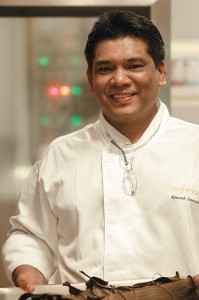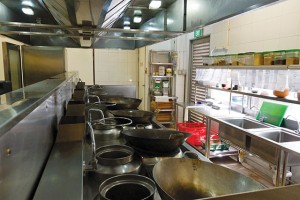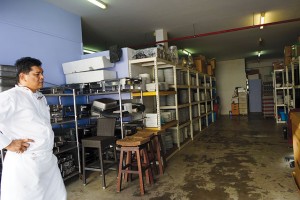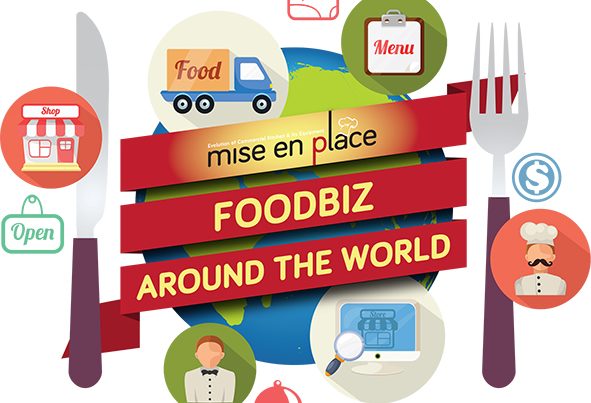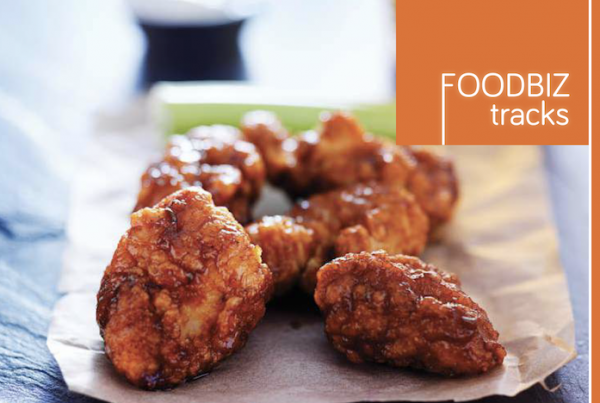We had the privilege of visiting the workplace of Chef Kenneth, the Executive Chef of Sentosa Leisure Management who showed us how he manages the high capacity kitchens that cooks for all the functions operating on Sentosa Island; except for Resort World Sentosa and other hotels on the island.
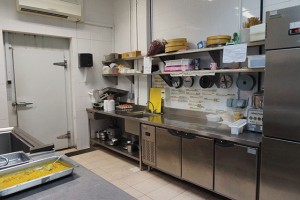 Although many large kitchens may operate on a certain amount of food cooked daily; especially if one considers employee cafeterias or hospitals, the operation handled by Chef Kenneth differs; for he looks at every menu that comes in like a project rather than a fixed or staple menu. From 8,000 to 25,000 people, his kitchen caters to many taste buds and since they have functions every weekend, the team could be cooking for a large group of youths in the day and a totally different menu for business guests or seniors with a different taste palate. How then does one navigate such diversity and demands? Chef Kenneth believes the number 1 rule is to understand your customers. Chefs are trained to know what suits the group of guests coming to dine and prepare a menu that is suitable yet a new experience for them. His principle is proven true as he has created menus for important people from various backgrounds like The Honorable President of Singapore, Ex-Prime Minister of Singapore, Presidents and CEOs of multinational companies, Chairman of De La Rue Currency for the World Bank, Ambassadors of various countries, to name a few.
Although many large kitchens may operate on a certain amount of food cooked daily; especially if one considers employee cafeterias or hospitals, the operation handled by Chef Kenneth differs; for he looks at every menu that comes in like a project rather than a fixed or staple menu. From 8,000 to 25,000 people, his kitchen caters to many taste buds and since they have functions every weekend, the team could be cooking for a large group of youths in the day and a totally different menu for business guests or seniors with a different taste palate. How then does one navigate such diversity and demands? Chef Kenneth believes the number 1 rule is to understand your customers. Chefs are trained to know what suits the group of guests coming to dine and prepare a menu that is suitable yet a new experience for them. His principle is proven true as he has created menus for important people from various backgrounds like The Honorable President of Singapore, Ex-Prime Minister of Singapore, Presidents and CEOs of multinational companies, Chairman of De La Rue Currency for the World Bank, Ambassadors of various countries, to name a few.
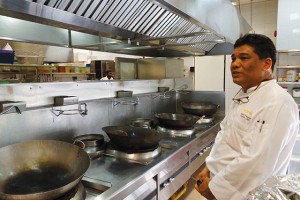 The second factor is the designing of the facility and fitting it with equipment that suits the menu. Knowing that Chef Kenneth was very much a part of cooking for the Youth Olympics in Singapore where he had 26 combi-ovens in a row to easily manage the high volume, it came as quite a surprise to find that his current kitchen is actually rather compact. It has 6 different areas but runs with only 12 staff in the main kitchens and 6 each in the 2 restaurants on the island – Port Belly and Tastes of Asia. There is an Asian kitchen, a Western Kitchen, a Butchery, a Cold Kitchen, a Pastry Kitchen and a non halal facility; not for proteins but more for food with alcohol as an ingredient. There is a row of woks in a line, a few combi- ovens, soup kettles and to the untrained, it would be hard to imagine that high volumes of food can be churned from a kitchen of this size. In Singapore, Chef Kenneth is fully aware that kitchens here rely heavily on equipment such as the combi-oven and cook-chill even though he has had the pleasure of working on a 4-day event on a tiny island where he and his team cooked and served with only open stoves over fire that employed more skill and experience. This is not saying that Chef Kenneth prefers or champions one over the other but it is more of knowing which expertise to put to use at which time and occasion. Regarding technology in equipment; he describes it as a love-hate situation for he feels that advancement in cook-chill has removed the need for a person to apply experience and skills to cook over a hot stove as control of fire is essential. With machines, everything follows a set procedure and it allows untrained personnel to cook well, as long as the right buttons are pressed. Yet he does not deny that cook-chill equipment is one of the best tools to maintain consistency when it comes to serving a huge crowd.
The second factor is the designing of the facility and fitting it with equipment that suits the menu. Knowing that Chef Kenneth was very much a part of cooking for the Youth Olympics in Singapore where he had 26 combi-ovens in a row to easily manage the high volume, it came as quite a surprise to find that his current kitchen is actually rather compact. It has 6 different areas but runs with only 12 staff in the main kitchens and 6 each in the 2 restaurants on the island – Port Belly and Tastes of Asia. There is an Asian kitchen, a Western Kitchen, a Butchery, a Cold Kitchen, a Pastry Kitchen and a non halal facility; not for proteins but more for food with alcohol as an ingredient. There is a row of woks in a line, a few combi- ovens, soup kettles and to the untrained, it would be hard to imagine that high volumes of food can be churned from a kitchen of this size. In Singapore, Chef Kenneth is fully aware that kitchens here rely heavily on equipment such as the combi-oven and cook-chill even though he has had the pleasure of working on a 4-day event on a tiny island where he and his team cooked and served with only open stoves over fire that employed more skill and experience. This is not saying that Chef Kenneth prefers or champions one over the other but it is more of knowing which expertise to put to use at which time and occasion. Regarding technology in equipment; he describes it as a love-hate situation for he feels that advancement in cook-chill has removed the need for a person to apply experience and skills to cook over a hot stove as control of fire is essential. With machines, everything follows a set procedure and it allows untrained personnel to cook well, as long as the right buttons are pressed. Yet he does not deny that cook-chill equipment is one of the best tools to maintain consistency when it comes to serving a huge crowd.
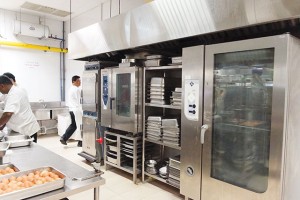 Supposedly there is a budget and space constraint for equipment, Chef Kenneth would choose cooking equipment over preparation equipment although the initial thought would be preparation is more tedious than cooking therefore should be expedited when possible. However, today’s suppliers are able to provide raw materials in shapes, sizes and form that provide a solution to processes that his kitchen might not be able to handle. When selecting equipment, Chef Kenneth mentions his top criteria to be service, support and the availability of parts. He provided us an example of a technical problem he faced from an equipment and Electrolux gave Chef Kenneth the assurance that – “if we can’t fix it, we will send you a new unit.” A technician was flown in all the way from Europe and it is this sort of commitment and service that Chef Kenneth feels should be adopted by all brands in the market. “Something as simple as a gasket for the fridge which Electrolux swapped for me without any questions asked showed that they were on top of the situation and handled the problem for me immediately”. On another hand, many chefs were not at the beginning of the planning stage and this would mean they ‘inherited a kitchen’, so to speak. We asked Chef Kenneth how he would work around this situation of unfamiliarity. He tells us that as a chef, he needs to study the business plan of the restaurant or facility and work with what he has. Having used many brands; from Rational, MKN, Electrolux, Angelo Po, he opines that when cooking for many kitchens at the same time and with untrained helpers, it is important that he can manage the equipment efficiently, hence preferring the ovens and equipment that quickly and easily load the processes, he also finds ovens with thumb drive storage handy.
Supposedly there is a budget and space constraint for equipment, Chef Kenneth would choose cooking equipment over preparation equipment although the initial thought would be preparation is more tedious than cooking therefore should be expedited when possible. However, today’s suppliers are able to provide raw materials in shapes, sizes and form that provide a solution to processes that his kitchen might not be able to handle. When selecting equipment, Chef Kenneth mentions his top criteria to be service, support and the availability of parts. He provided us an example of a technical problem he faced from an equipment and Electrolux gave Chef Kenneth the assurance that – “if we can’t fix it, we will send you a new unit.” A technician was flown in all the way from Europe and it is this sort of commitment and service that Chef Kenneth feels should be adopted by all brands in the market. “Something as simple as a gasket for the fridge which Electrolux swapped for me without any questions asked showed that they were on top of the situation and handled the problem for me immediately”. On another hand, many chefs were not at the beginning of the planning stage and this would mean they ‘inherited a kitchen’, so to speak. We asked Chef Kenneth how he would work around this situation of unfamiliarity. He tells us that as a chef, he needs to study the business plan of the restaurant or facility and work with what he has. Having used many brands; from Rational, MKN, Electrolux, Angelo Po, he opines that when cooking for many kitchens at the same time and with untrained helpers, it is important that he can manage the equipment efficiently, hence preferring the ovens and equipment that quickly and easily load the processes, he also finds ovens with thumb drive storage handy.
On top of having the right tools, the planning for a high capacity kitchen is crucial. Stock movement for both raw and dry produce, time management, utilising the right equipment at the right time and how you store and transport your food all affects each other. While he was on this topic, we asked him on the food waste issue that we are looking into. In his practice, Chef Kenneth factors in a produce at every process. From receiving to preparation to cooking and serving, all trimmings and cuts from the original produce are given deeper thought to see if it can be taken to another level. Despite cooking for thousands, the chef says the food waste in his kitchen is not exceptionally extensive as trimming from vegetables are used for consommé or meat trimmings included in the mix for burger patties. It might take an extra step but it is important to Chef Kenneth as it maintains a low level of cost and wastage. Before Chef Kenneth moved on to his next task, he advised to “Know your basics, be it your ingredient, your processes and your equipment. In running a large kitchen at the high volume, you need to be able to trust your team and also your equipment to work for you”. Our sincere thanks to Chef Kenneth for his time and insights.

